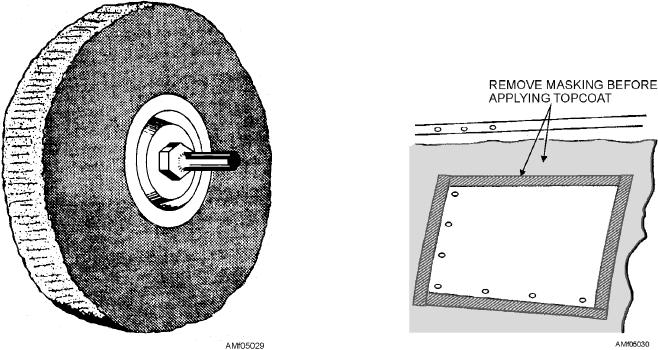
The major portion of thick paint films may be removed
the fiber. When you use a flap brush, apply minimum
with an oscillating sander with 240 or finer grit
pressure to remove the maximum amount of paint and
aluminum oxide cloth. Do not allow the oscillating
the minimum amount of metal. Excessive pressure will
sander to touch bare metal. The contact between an
cause some paints to melt, gum up, and streak. Eye
operating sander and bare metal will damage the metal,
protection should be worn when you are operating a
which, in turn, may cause future corrosion. The
flap brush.
oscillating sander should not be used after first
SCUFF SANDING.--Aged paint surfaces should
indications of primer exposure. You should use a flap
be scuff sanded to ensure the adhesion of the
brush or hand-held 240 grit or finer aluminum oxide
overcoating paint. Scuff sanding is the roughening of a
cloth for final feathering operations.
paint surface as evidenced by a significant reduction of
TREAT AND SEAL.--Chemical conversion
the gloss. To scuff sand, you should use aluminum
treatment is an extremely important part of the
oxide cloth, abrasive mats, or an oscillating sander with
corrosion control process. Properly applied chemical
aluminum oxide cloth. Scuff sanding to a depth greater
treatments impart corrosion resistance to metal. It also
than necessary may result in complete removal of the
improves the adhesion of the paint system. You should
paint. This situation will expose the underlying metal,
use chemical conversion coating materials according to
and corrosion may develop. Unevenly matched faying
the procedures outlined in the NA 01-1A-509.
surface joints or fasteners and sharply protruding
objects or corners should be scuff sanded by hand to
First, you should remove all loose seam sealants in
avoid sanding through the paint. After sanding, you
the area to be touched up. Replace them as necessary.
should remove the residue with a clean, cotton
You should also secure loose rubber seals with the type
cheesecloth dampened with MIL-T-81772 thinner.
of adhesive specified in the applicable MIM.
PAINT FEATHERING.--You should feather the
The area to be painted should be outlined with tape
paint along the edge of an area that has been chemically
and masking paper, as shown in figure 5-30. This
stripped to ensure a smooth, overlapping transition
protects the adjoining surfaces from overspray and
between the old and new paint surfaces. The smooth
paint buildup.
overlapping paint film will prevent soil from
accumulating in the junction between the old and new
TOUCHUP PROCEDURES
paint films. Feathering should be accomplished with
280 or 320 grit aluminum oxide cloth or a flap brush.
A standardized paint system for organizational and
intermediate level painting and paint touchup has been
developed by the Naval Air Systems Command.
Standardized exterior paint touchup consists of an
Figure 5-29.--Flap brush with mandrel.
Figure 5-30.--Masking prior to paint touchup.
5-27

